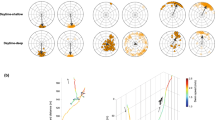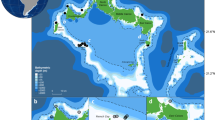Abstract
The present study examines the potential capability of Caribbean reef sharks to perceive human body orientation, as well as discussing the sharks’ swimming patterns in a person’s vicinity. A standardized video method was used to record the scenario of single SCUBA divers kneeling in the sand and the approach patterns of sharks, combined with a control group of two divers kneeling back-to-back. When approaching a single test-subject, significantly more sharks preferred to swim outside the person’s field of vision. The results suggest that these sharks are able to identify human body orientation, but the mechanisms used and factors affecting nearest distance of approach remain unclear.
Similar content being viewed by others
References
Baldridge HD (1988) Shark aggression against man: beginnings of an understanding. Calif Fish Game 74:208–217
Blair RC, Sawilowsky SS, Higgins JJ (1987) Limitations of the rank transform in factorial ANOVA. In: Balakrishnan N (ed) Communications in statistics: computations and simulations B16. Taylor and Francis, London, pp 1133–1145
Bleekmann H (1986) Role of the lateral line in fish behaviour. In: Pitcher TJ (ed) Behaviour of teleost fishes. Springer, US, pp 177–202
Bond ME, Babcock EA, Pikitch EK, Abercrombie DL, Lamb NF, Chapman DD (2012) Reef sharks exhibit site-fidelity and higher relative abundance in marine reserves on the Mesoamerican Barrier Reef. PLoS ONE 7(3):e32983. doi:10.1371/journal.pone.0032983
Braithwaite VA, Boulcott P (2007) Pain perception, aversion and fear in fish. Dis Aquat Org 75:131–138
Byard RW, Gilbert JD, Brown K (2000) Pathologic features of fatal shark attacks. Am J Forens Med Pathol 21:225–229
Call J, Bräuer J, Kaminski J, Tomasello M (2003) Domestic dogs (Canis familiaris) are sensitive to the attentional state of humans. J Comp Psychol 117:257–263
Chandroo KP, Duncan IJH, Moccia RD (2004) Can fish suffer?: perspectives on sentience, pain, fear and stress. Appl Anim Behav Sci 86:225–250
Collier RS (1992) Recurring attacks by white sharks on test-subjects at two Pacific sites off Mexico and California. Env Biol Fish 33:319–325
Compagno LJV (1984) Sharks of the world. Part 2: Carcharhiniformes. FAO species catalogue
Conover WJ (1999) Practical nonparameteric statistics, 3rd edn. Wiley, New York, pp 396–406
Cooper WE, Frederick WG (2007) Optimal fight initiation distance. J Theor Biol 244:59–67
Domenici P, Blake R (1997) The kinematics and performance of fish fast-start swimming. J Exp Biol 200:1165–1178
Frid A, Dill L (2002) Human-caused disturbance stimuli as a form of predation risk. Conserv Ecol 6, 11. http://www.consecol.org/vol6/iss1/art11. Accessed 2013
Gácsi M, Miklósi A, Varga O, Topál J, Csáni V (2004) Are readers of our face readers of our minds? Dogs (Canis familiaris) show situation-dependent recognition of human’s attention. Anim Cogn 7:144–153
Garla RC, Chapman DD, Wetherbee BM, Shivji M (2006) Movement patterns of young Caribbean reef sharks, Carcharhinus perezi, at Fernando de Noronha Archipelago, Brazil: the potential of marine protected areas for conservation of a nursery ground. Mar Biol 149:189–199
Goulet J, Engelmann J, Chagnaud BP, Franosch JP, Suttner J, van Hemmen L (2008) Object localization through the lateral line system of fish: theory and experiment. J Comp Physiol A 194:1–17
Hambright KD (1991) Experimental analysis of prey selection by largemouth bass: role of predator mouth width and prey body depth. Trans Am Fish Soc 120:500–508
Hampton RR (1994) Sensitivity to information specifying the line of gaze of humans in sparrows (Passer domesticus). Behaviour 130:41–51
Hare B, Tomasello M (1999) Domestic dogs (Canis familiaris) use human and conspecific social cues to locate hidden food. J Comp Psych 113:173–177
Hare B, Call J, Agnetta B, Tomasello M (2000) Chimpanzees know what conspecifics do and do not see. Anim Behav 59:771–785
Heithaus MR, Dill LM, Marshall GJ, Buhleier B (2002) Habitat use and foraging behavior of tiger sharks (Galeocerdo cuvier) in a seagrass ecosystem. Mar Biol 140:237–248
Heupel MR, Simpfendorfer CA, Fitzpatrick R (2010) Large-scale movement and reef fidelity of grey reef sharks. PLoS ONE 5(3):e9650. doi:10.1371/journal.pone.0009650
Huntingford FA, Adams C, Braithwaite VA, Kadri S, Pottinger TG, Sandøe P, Turnbull JF (2006) Current issues in fish welfare. J Fish Biol 68:332–372
Itakura S, Anderson JR (1996) Learning to use experimenter-given cues during an object-choice task by a capuchin monkey. Curr Psychol Cogn 15:103–112
Kaminski J, Call J, Tomasello M (2004) Body orientation and face orientation: two factors controlling apes’ begging behavior from humans. Anim Cogn 7:216–233
Levine M (1996) Unprovoked attacks by white sharks off the South African coast. In: Klimely AP, Ainley DG (eds) Great white sharks. The biology of Carcharodon carcharias. Academic Press, San Diego, pp 435–448
Martin RA (2007) A review of shark agonistic displays: comparison of display features and implications for shark–human interactions. Mar Freshw Behav Physiol 40:3–34
McComb DM, Tricas TC, Kajiura SM (2009) Enhanced visual fields in hammerhead sharks. J Exp Biol 212:4010–4018
McKinley J, Sambrook TD (2000) Use of human-given cues by domestic dogs (Canis familiaris) and horses (Equus caballus). Anim Cogn 3:13–22
Pack AA, Herman LM (2004) Bottlenosed dolphins (Tursiops truncatus) comprehend the referent of both static and dynamic human gazing and pointing in an object-choice task. J Comp Psychol 118:160–171
Pettigrew JD (1991) Evolution of binocular vision. In: Cronly-Dillon JR, Gregory RL (eds) Vision and visual dysfunction, vol 2., Evolution of the eye and visual sytem. CRC Press, Boca Raton, pp 271–283
Povinelli DJ, Eddy TJ (1996) What young chimpanzees know about seeing. Monogr Soc Res Child Dev 61:1–152
Ritter EK (2006) Understanding sharks. Krieger, Melbourne
Ritter EK (2012) Shark–human interaction. Situations findings recommendations. Shark School Publishing, Pensacola
Ritter EK, Amin RW (2012) Effect of human body position on the swimming behavior of bull sharks, Carcharhinus leucas. Soc Anim 20:225–235
Ritter EK, Levine M (2004) Use of forensic analysis to better understand shark attack behaviour. J Forensic Odontostomatol 22:40–46
Ritter EK, Levine M (2005) Bite motivation of sharks reflected by the wound structure on humans. Am J Forensic Med Pathol 26:136–140
Ritter E, Lutz K, Levine M (2008) When humans and sharks meet. In: Olsson F (ed) New developments in the psychology of motivation. Nova Biomedical Books, New York, pp 45–52
Sand O, Enger PS, Karlsen HE, Kudsen FR (2001) Detection of infrasound in fish and behavioral responses to intense infrasound in juvenile salmonids and European silver eels: a minireview. Am Soc Symp 26:183–193
Sawilowsky S (1985) Robust and power analysis of the 2 × 2 × 2 ANOVA, rank transformation, random normal scores, and expected transformation tests. Unpublished doctoral dissertation, University of South Florida
Sawilowsky S (1990) Nonparametric tests of interaction in experimental design. Rev Educ Res 60(1):91–126
Sawilowsky S, Blair RC, Higgins JJ (1989) An investigation of the type I error and power properties of the rank transform procedure in factorial ANOVA. J Educ Stat 14(3):255–267
Scharf FS, Juanes F, Rountree RA (2000) Predator size–prey size relationships of marine fish predators: interspecific variation and effects of ontogeny and body size on trophic-niche breadth. Mar Ecol Prog Ser 208:229–248
Schloegl C, Kotrschal K, Bugnyar T (2008) Do common ravens (Corvus corax) rely on human or conspecific gaze cues to detect hidden food? Anim Cogn 11:231–241
Shark Research Institute (2013) http://www.sharkattackfile.net. Accessed 1 May, 2013
Tavares R (2009) Fishery biology of the Caribbean reef sharks, Carcharhinus perezi (Poey, 1876), in a Caribbean insular platform: Los Roques Archipelago National Park, Venezuela. Pan-Am J Aquat Sci 4:500–512
Stankowich T, Blumstein DT (2005) Fear in animals: a meta-analysis and review of risk management. Proc R Soc 272:2627–2634
Thompson GL (1991) A note on the rank transform for interactions. Biometrika 78(3):697–701
Thompson GL, Ammann LP (1989) Efficiencies of the rank-transform in two-way models with no interaction. J Am Stat Assoc 4(405):325–330
van der Waerden BL (1952) Order tests for the two-sample problem and their power. Indag Math 14:453–458
Acknowledgments
We thank M. Tomasello and A. Miklósi for their suggestions, as well as the two anonymous reviewers for critical reading of the manuscript and editorial suggestions. Furthermore, we also thank the test-subjects for their efforts, which made this project possible.
Author information
Authors and Affiliations
Corresponding author
Rights and permissions
About this article
Cite this article
Ritter, E.K., Amin, R. Are Caribbean reef sharks, Carcharhinus perezi, able to perceive human body orientation?. Anim Cogn 17, 745–753 (2014). https://doi.org/10.1007/s10071-013-0706-z
Received:
Revised:
Accepted:
Published:
Issue Date:
DOI: https://doi.org/10.1007/s10071-013-0706-z




